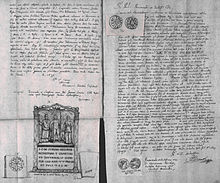User:Pelirojopajaro/Vetera

Vetera (also: Vetera Castra; occasionally in older literature, on maps and colloquially Castra Vetera) was the name for the location of two successive Roman Legion camps in the province Germania inferior near modern Xanten. The Vetera camps belong to the Lower Germanic Limes.
The scientific literature differentiates between the older Vetera I (13/12 BC to 70 AD) and younger Vetera II (71 to 275/276 AD). Vetera was one of the most important garrisons on the northern flank of the Roman Empire and was in its early days an important deployment base for the Romans on the right side of the Rhine.
Location

Vetera I was located on the southern slope of a mountain called Fürstenberg, which in ancient times was surrounded by swamps, moorland and terminal moraines, about two kilometers south-southeast of the center of Xanten. Today's archaeological argument lies under largely agriculturally used surfaces immediately north-northwest of the Xantener district Birten. In antiquity, the camp was in an exposed position opposite the mouth of the
The course of the Rhine in Roman times was similar to today's course, with only a slight shift south and west. Control over the Rhine and Lippe valleys was made possible by the excellent position on Fürstenberg.
Vetera II was built in 71 AD about 1.5 km east of Vetera I on a flood-free fluvial terrace of the Rhine.
Ancient sources and naming of the forts
The name Vetera was first mentioned by Cornelius Tacitus in his Historiae.
The name probably goes back to a nearby, pre-Roman Cugerni settlement, whose Germanic name was Romanized and transferred to the forts.
Research history
Immediately after its abandonment, the Roman military camps were used as quarries, first by the Romans themselves, who used the stone material of Vetera I to advance the development of the neighboring Colonia Ulpia Traiana. In the Middle Ages, the remaining ruins served as a quarry for the construction of the monastery on the Fürstenberg. Vetera II, however, disappeared around the year 1200, when the Rhine formed a southbound sling and thereby flushed the previously flood-free area of the fort, so that the finds and findings of Vetera II are today visible five to ten meters below the surface.


The extensive Roman remains in the Xanten area aroused the interest of scholars early on. Stephen Winandus Pighius (1526-1604), a scholaster and canon Xanten Cathedral from 1575, was the first to make systematic records of Roman relics. From 1623 to 1633, Johannes Turck illustrated a Klevic chronicle by Gert van der Schuiren with drawings of ancient legacies. He was followed by the pastor Hermann Ewich, who documented the antiquities of his native region of Wesel between 1628 and 1654, as well as the theologian and humanist Werner Teschenmacher (1590-1638). At the end of the 17th and 18th centuries, priests Theodore Tack and especially Johannes Spenrath devoted themselves to the ancient heritage of the Xanten area.
Even Pighius had complained of the progressing depletion of the Roman ruins, yet he continued unabated despite the increasing interest and protests of some scholars. Just between 1714 and 1716, the pastor Johannes Spenrath reported more than 5000 tons of stones from Vetera I were uncovered. Overall, the clearly documented in old sources stone eruptions from the Middle Ages to modern times such dimensions, that the insignificance of visible traces can hardly surprise today. The excavations carried out since the early modern period were not yet scientifically investigated

On the threshold between antuwue collecting and scientific archeology was Philipp Houben (1767–1855). Houben arrived in Xanten in 1798 and was infected by Johannes Spenrath with a passion for classical studies. In 1803 he founded the first Xanten Museum, by buying the old provost of the place and furnishing it with antique finds. Between 1819 and 1844 he carried out at his own expense extensive excavations in the area of the legion camp, the CUT and the burial grounds. He went more carefully than his predecessors to work and documented as the first not only the finds, but also the excavations and sites themselves. At about the same time and partly together with Houben, whose graphic documentations he provided with texts, the Weseler senior teacher Franz Fiedler(1790-1876) worked in the Xanten area.

Another step on the way to modern archeology was the foundation of the Lower Rhine antiquity association, which was operated by the Xanten doctor Josef Steiner and took place in 1877.
Historical background
[[Category:History of the Rhineland]] [[Category:Featured articles]]
